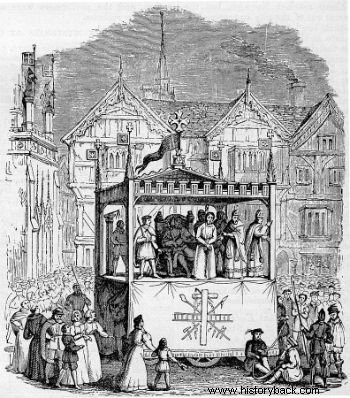The medieval theater is one that was produced in the medieval era (5th to 15th century). During this period, medieval theater can be classified in two ways:
- the sacred theater, related to religious themes;
- profane theatre, like farces and jesters, with popular, comic and moralizing themes.
After the fall of the Roman Empire, the Catholic Church controlled the lives of citizens and the theater was considered a profane and satirical art and for this reason it was banned by the Church until the 12th century, when it began to resurge in Europe.
Origin of Medieval Theater
 Medieval Theater Representation
Medieval Theater Representation
Medieval theater began in the 12th century and lasted until the 15th century, with the arrival of the Renaissance period.
Its origin is related to the celebrations held in favor of religious festivities, whether Easter, Christmas, among others.
They were originally texts performed by clerical members after masses or processions and had as their themes biblical passages, miracles, mysteries, sermons, sacramental acts, biographies of saints and liturgical dramas. Many of them were presented in Latin.
This characteristic is closely related to the historical context of domination by the Catholic Church and the philosophical aspect of the Middle Ages, where theocentrism was the key concept, that is, God was the center of the world, he who ruled the entire universe.
Later, the medieval theater adapted to the changes and included broader themes, that is, with presentations on the life and customs of human beings, which offered a didactic and moralizing character.
Differently from its origin, in which brief stagings were performed inside churches, medieval theater began to be developed in public environments, for example in squares. The characters became ordinary people and not just members of the clergy.
Furthermore, initially the plays were brief and only featured religious passages; over time, the medieval theater was improved and the staging could be presented for days.
Learn more about the historical context in the article:Middle Ages.
Key Features:Summary
Although the medieval era is a long period of history (5th to 15th century) that gradually changed, the main characteristics of medieval theater were:
- Oral tradition
- Popular character
- Scenic space:churches and squares
- Sacred and profane topics
- Uses of masks
- Allegorical characters
- Union of dance, music and theater
Example of Medieval Theater
While many medieval texts are oral and therefore lost over time, some pieces from this period have survived.
Thus, to better understand the language of medieval theater, below is an excerpt from the popular play written around the 13th century by the French playwright Rutebeuf entitled “O pregão das Hervas ” (in French “Le Dit of l'Herberie ”)
To expand your knowledge on the topic:
- History of Theater
- Medieval Culture
- Medieval Art
- Medieval Prose
- Greek Theater
- Theatrical Text
- Theatrical Language
